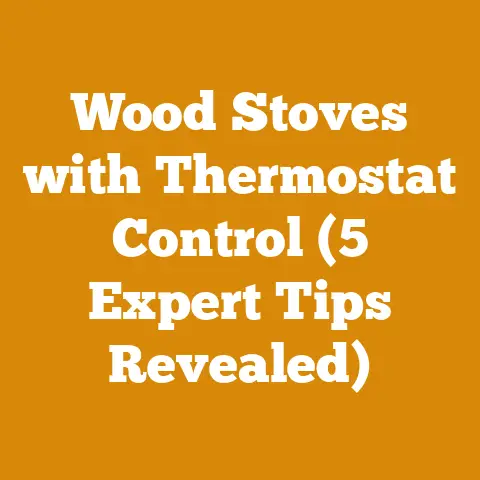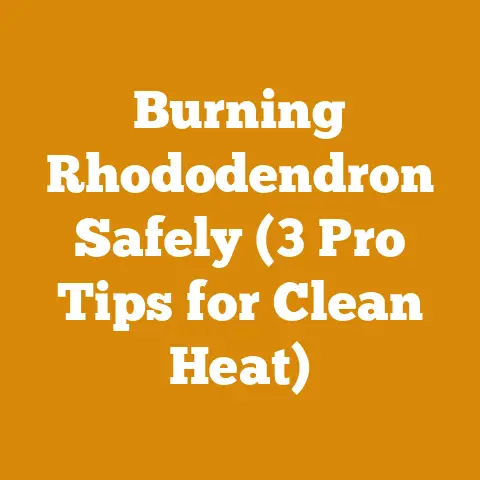Non Electric Gravity Feed Pellet Stove (5 Pro Tips for Wood Heating)
Craftsmanship isn’t just about the final product; it’s about the journey, the understanding of the material, and the respect for the process.
For me, it’s always been about the dance between man and wood, a relationship forged in sweat, sawdust, and the satisfying crack of a well-split log.
I’ve spent years in the woods, from my early days helping my grandfather with his woodlot to managing larger-scale firewood operations.
I’ve seen firsthand the evolution of wood heating, and while technology marches on, some solutions remain beautifully simple and incredibly effective.
Today, I want to share my insights on one such solution: the non-electric gravity feed pellet stove.
Non-Electric Gravity Feed Pellet Stove: 5 Pro Tips for Wood Heating
These stoves represent a return to simpler times, offering a reliable, off-grid heating solution that doesn’t rely on electricity.
They work on the principle of gravity, feeding pellets from a hopper into a burn pot where they combust, providing consistent heat.
But to truly harness their potential, you need more than just the stove itself.
You need a strategy, a plan, and a few insider tips.
1. Pellet Quality is King: Sourcing and Storage Strategies
The heart of any pellet stove, electric or non-electric, is the pellet itself.
The quality of your pellets directly impacts the stove’s efficiency, heat output, and maintenance requirements.
I cannot stress this enough: cheap pellets are rarely a bargain.
Sourcing Matters: I’ve learned this the hard way.
I once bought a bulk load of “discount” pellets that turned out to be full of dust and debris.
They burned poorly, produced excessive ash, and clogged my stove’s feed system.
Now, I only buy pellets from reputable suppliers who can provide information about the wood species, moisture content, and ash content.
Look for certifications like the Pellet Fuels Institute (PFI) grading system, which indicates the pellets meet certain quality standards.- PFI Standards: The PFI grading system classifies pellets into three categories: Premium, Standard, and Utility.
Premium pellets have the lowest ash content (less than 1%) and produce the most consistent heat.
Standard pellets have a slightly higher ash content (1-3%) and may require more frequent cleaning.
Utility pellets are the lowest grade and are generally not recommended for non-electric stoves due to their high ash content and inconsistent burn. -
Moisture is the Enemy: Pellets should be stored in a dry, sheltered location.
Moisture can cause them to swell, crumble, and become unusable.
I store my pellets in airtight containers in my garage, away from direct sunlight and humidity.
I’ve found that a simple dehumidifier in the storage area during damp months can make a huge difference. -
Data Point: A study by the Biomass Energy Resource Center found that pellets with a moisture content above 10% can lose up to 25% of their heating value.
This translates to needing significantly more pellets to achieve the same level of heat. -
Species Considerations: Different wood species burn at different temperatures and produce varying amounts of ash.
Hardwood pellets, such as oak or maple, generally burn hotter and longer than softwood pellets, such as pine or fir.
However, softwood pellets may be more readily available and less expensive.
Experiment with different types of pellets to find what works best for your stove and your heating needs. -
Personal Experience: I live in a region where softwood is abundant.
While hardwood pellets are available, they’re considerably more expensive.
I’ve found that a blend of 70% softwood and 30% hardwood pellets provides a good balance of heat output and cost-effectiveness. - Bulk vs.
Bagged: Buying pellets in bulk can save you money, but it requires a suitable storage solution.
Bagged pellets are more convenient for smaller spaces and easier to handle.
Consider your storage capacity and usage rate when deciding between bulk and bagged pellets.
I usually buy in bulk in the summer when prices are lower and store them in large, airtight bins. - Pro Tip: Before loading pellets into your stove, inspect them for signs of damage or moisture.
Discard any pellets that are crumbling or appear damp.
A small investment in a pellet sifter can also help remove dust and debris, improving the stove’s efficiency.
- PFI Standards: The PFI grading system classifies pellets into three categories: Premium, Standard, and Utility.
2. Mastering the Airflow: Optimizing Combustion for Maximum Heat
Non-electric gravity feed pellet stoves rely on natural convection to draw air through the combustion chamber.
Proper airflow is crucial for efficient burning and optimal heat output.
Chimney Draft is Key: A strong, consistent chimney draft is essential for pulling air through the stove.
Make sure your chimney is properly sized and clean.
I recommend having your chimney inspected and cleaned annually by a qualified professional.
Creosote buildup can restrict airflow and increase the risk of a chimney fire.- Industry Statistic: According to the National Fire Protection Association (NFPA), creosote buildup is a leading cause of chimney fires.
Regular chimney cleaning can significantly reduce this risk. - Stove Placement Matters: The location of your stove can impact its airflow.
Avoid placing the stove in a drafty area or near obstructions that could block the flow of air.
I’ve found that placing the stove in a central location in the room allows for better heat distribution. -
Adjusting the Air Intake: Most non-electric pellet stoves have an adjustable air intake that allows you to control the amount of air entering the combustion chamber.
Experiment with different settings to find the optimal balance between heat output and burn time.
Too much air can cause the pellets to burn too quickly, while too little air can result in smoldering and incomplete combustion. -
Personal Experience: I spent a lot of time experimenting with the air intake on my stove when I first got it.
I found that a slightly restricted airflow resulted in a longer burn time and more consistent heat output.
However, it’s important to monitor the stove closely to ensure that the pellets are burning cleanly and efficiently. - Regular Cleaning is Essential: Ash buildup can restrict airflow and reduce the stove’s efficiency.
Clean the burn pot and ash pan regularly, following the manufacturer’s instructions.
I usually clean my stove every few days during peak heating season. - Pro Tip: Use a leaf blower to clean out your stove exhaust piping.
This will remove fine ash that a brush may miss.
- Industry Statistic: According to the National Fire Protection Association (NFPA), creosote buildup is a leading cause of chimney fires.
3. Fine-Tuning the Feed Rate: Achieving Consistent Heat Output
The feed rate determines how quickly pellets are fed into the burn pot.
Adjusting the feed rate allows you to control the stove’s heat output and burn time.
- Understanding the Gravity Feed Mechanism: Non-electric pellet stoves use gravity to feed pellets into the burn pot.
The feed rate is typically controlled by adjusting the size of the opening between the hopper and the burn pot. - Start with the Manufacturer’s Recommendations: The stove’s manual will provide recommended feed rate settings for different heating needs.
Start with these settings and adjust them as needed based on your experience. - Observe the Burn: Pay close attention to the way the pellets are burning.
If the pellets are burning too quickly, reduce the feed rate.
If they are smoldering or not burning completely, increase the feed rate. Adjust for Weather Conditions: You may need to adjust the feed rate depending on the weather conditions.
On colder days, you may need to increase the feed rate to maintain a comfortable temperature.
On milder days, you can reduce the feed rate to conserve pellets.- Data Point: A study by the U.S.
Department of Energy found that adjusting the feed rate of a pellet stove can improve its efficiency by up to 15%. - Pro Tip: Keep a log of your feed rate settings and the corresponding temperature readings.
This will help you fine-tune your stove’s performance and optimize its efficiency.
A small notebook kept near the stove can be invaluable.
- Data Point: A study by the U.S.
4. Safety First: Preventing Hazards and Ensuring Safe Operation
Wood heating can be safe and enjoyable, but it’s crucial to prioritize safety and take precautions to prevent hazards.
- Proper Installation is Paramount: Have your stove installed by a qualified professional who is familiar with local building codes and safety regulations.
Improper installation can lead to fire hazards and carbon monoxide poisoning. Carbon Monoxide Detection: Install carbon monoxide detectors on every level of your home, especially near sleeping areas.
Test the detectors regularly and replace the batteries as needed.
Carbon monoxide is a colorless, odorless gas that can be deadly.- Statistic: According to the Centers for Disease Control and Prevention (CDC), carbon monoxide poisoning is a leading cause of unintentional poisoning deaths in the United States.
- Maintain Clearances: Keep flammable materials, such as furniture, curtains, and clothing, away from the stove.
Follow the manufacturer’s recommended clearances. - Supervise Children and Pets: Keep children and pets away from the stove to prevent burns.
Install a safety screen around the stove if necessary. - Never Use Flammable Liquids: Never use flammable liquids, such as gasoline or kerosene, to start or accelerate the fire.
-
Dispose of Ashes Safely: Allow ashes to cool completely before disposing of them.
Store ashes in a metal container with a tight-fitting lid and keep it away from flammable materials. -
Personal Experience: I once had a close call when I carelessly disposed of hot ashes in a cardboard box.
The box smoldered for hours before I noticed the smoke.
I learned my lesson and now always use a metal container for ash disposal. - Have a Fire Extinguisher Handy: Keep a fire extinguisher nearby and make sure everyone in your household knows how to use it.
- Emergency Plan: Develop a fire escape plan and practice it regularly with your family.
- Pro Tip: Consider adding a hearth pad under the stove.
This will protect the floor from heat and embers.
5. Long-Term Maintenance: Extending the Life of Your Stove
Proper maintenance is essential for keeping your non-electric gravity feed pellet stove running smoothly and efficiently for years to come.
- Regular Cleaning: As mentioned earlier, regular cleaning is crucial for maintaining airflow and preventing ash buildup.
Clean the burn pot, ash pan, and chimney regularly. - Inspect and Replace Worn Parts: Inspect the stove for worn or damaged parts, such as gaskets, seals, and grates.
Replace these parts as needed. - Lubricate Moving Parts: Lubricate any moving parts, such as the feed mechanism, with a high-temperature lubricant.
- Professional Servicing: Have your stove professionally serviced every year or two.
A qualified technician can inspect the stove, clean it thoroughly, and identify any potential problems. - Proper Storage During Off-Season: When you’re not using the stove, clean it thoroughly and store it in a dry, sheltered location.
Cover the stove to protect it from dust and moisture. - Pro Tip: Keep a maintenance log to track when you clean the stove, replace parts, and perform other maintenance tasks.
This will help you stay on top of your stove’s maintenance needs and extend its lifespan.
Beyond the Basics: Advanced Techniques and Considerations
Now that we’ve covered the essential pro tips, let’s delve into some advanced techniques and considerations that can further enhance your wood heating experience with a non-electric gravity feed pellet stove.
1. Zone Heating Strategies
Non-electric pellet stoves excel at zone heating, allowing you to focus the heat in the areas where you spend the most time.
This can significantly reduce your overall heating costs.
- Supplemental Heating: Use the pellet stove as a supplemental heating source during the coldest months of the year.
This can reduce your reliance on your primary heating system and save you money on energy costs. - Backup Heating: Use the pellet stove as a backup heating source in case of a power outage.
This can provide peace of mind and ensure that you stay warm even when the electricity is out. - Thermostat Integration: Some pellet stoves can be integrated with thermostats to automatically adjust the heat output based on the room temperature.
- Pro Tip: Consider using a smart thermostat to control your primary heating system and optimize its performance in conjunction with your pellet stove.
3. Sustainable Pellet Sourcing
Choosing sustainably sourced pellets is crucial for minimizing the environmental impact of wood heating.
- Look for Certifications: Look for pellets that are certified by organizations such as the Sustainable Biomass Program (SBP) or the Forest Stewardship Council (FSC).
These certifications indicate that the pellets are made from sustainably harvested wood. - Support Local Producers: Support local pellet producers who use sustainable forestry practices.
This can reduce transportation costs and support the local economy. - Consider Alternative Fuels: Explore alternative pellet fuels, such as agricultural residues or recycled wood waste.
These fuels can be a more sustainable option than virgin wood pellets. - Pro Tip: Ask your pellet supplier about their sourcing practices and environmental policies.
This can help you make informed decisions about the pellets you buy.
4. Troubleshooting Common Issues
Even with proper maintenance, you may encounter occasional issues with your non-electric gravity feed pellet stove.
Here are some common problems and their solutions:
- Stove Not Lighting: Make sure the burn pot is clean, the air intake is open, and the pellets are dry.
- Stove Smoking: Check the chimney for obstructions, adjust the air intake, and ensure that the pellets are burning cleanly.
- Stove Not Producing Enough Heat: Increase the feed rate, use higher-quality pellets, and ensure that the stove is properly sealed.
- Stove Shutting Down: Check the fuel level, clean the burn pot, and ensure that the stove is not overheating.
- Pro Tip: Consult your stove’s manual for detailed troubleshooting instructions.
5. Optimizing Burn Time
Getting the most burn time out of a single load of pellets is key to maximizing efficiency and reducing the frequency of refills.
- Lower Airflow: Restricting airflow slightly (without causing smoldering) can extend burn time.
Experiment with small adjustments to the air intake. - Pellet Density: Denser pellets, often from hardwood, tend to burn longer.
- Insulated Stove Pipe: An insulated stove pipe helps retain heat, improving overall efficiency and potentially extending burn time.
- Consistent Fuel Level: Keeping the hopper relatively full can help maintain a consistent feed rate.
- Pro Tip: Don’t overload the burn pot when starting the stove.
A smaller initial fire can establish a more efficient burn cycle.
My Personal Journey and Lessons Learned
I’ve seen a lot of changes in the wood heating world.
My grandfather used to heat his entire house with a massive wood-burning stove.
It was a lot of work – felling trees, bucking logs, splitting wood, stacking it to dry – but it was also a way of life.
He taught me the value of hard work, the importance of respecting the environment, and the satisfaction of providing for yourself.
When I started using pellet stoves, I was initially skeptical.
I missed the crackle and aroma of burning wood.
But I quickly realized that pellet stoves offered a level of convenience and efficiency that traditional wood stoves couldn’t match.
And with non-electric gravity feed models, I could still enjoy the benefits of wood heating without relying on electricity.
One of my biggest challenges was finding the right pellets.
I tried several different brands and types before I found one that worked well in my stove.
I also learned the importance of proper storage.
I once left a bag of pellets outside in the rain, and they turned into a soggy mess.
Now, I store all my pellets in airtight containers in my garage.
I’ve also learned a lot about airflow.
I initially struggled to get my stove to burn efficiently.
But after experimenting with different air intake settings, I was able to find the sweet spot.
Now, my stove burns cleanly and efficiently, providing consistent heat throughout my home.
The biggest lesson I’ve learned is that wood heating is not a set-it-and-forget-it solution.
It requires attention, effort, and a willingness to experiment.
But the rewards are well worth it.
Wood heating can save you money on energy costs, reduce your carbon footprint, and provide a sense of self-reliance.
Current Trends and Best Practices
The world of wood heating is constantly evolving, with new technologies and best practices emerging all the time.
Here are some current trends to keep in mind:
- Smart Stove Technology: Some pellet stoves are now equipped with smart technology that allows you to control them remotely using your smartphone or tablet.
This can make it easier to manage your heating and optimize its efficiency. - Advanced Combustion Systems: New combustion systems are being developed that burn pellets more cleanly and efficiently.
These systems can reduce emissions and improve the overall performance of pellet stoves. - Sustainable Fuel Sources: There is growing interest in using alternative fuel sources, such as agricultural residues and recycled wood waste, to make pellets.
This can reduce the environmental impact of wood heating. - Government Incentives: Many governments are offering incentives to encourage the use of renewable energy sources, including wood heating.
These incentives can help offset the cost of purchasing a pellet stove and installing it in your home.
Overcoming Common Challenges
While non-electric gravity feed pellet stoves offer many advantages, they also come with their own set of challenges.
Here are some common challenges and how to overcome them:
- Limited Heat Output: Non-electric pellet stoves typically have a lower heat output than electric models.
This can be a challenge in larger homes or in extremely cold climates.
To overcome this challenge, consider using multiple stoves or supplementing your pellet stove with another heating system. - Manual Operation: Non-electric pellet stoves require manual operation, which can be inconvenient for some people.
You need to manually load the pellets, adjust the feed rate, and clean the stove.
If you prefer a more automated solution, consider an electric pellet stove. - Chimney Requirements: Pellet stoves require a properly sized and installed chimney.
This can be a challenge in some homes, especially older ones.
If you don’t have a suitable chimney, you may need to install one, which can be expensive. - Pellet Storage: Storing pellets can be a challenge, especially if you don’t have a lot of space.
You need to store the pellets in a dry, sheltered location to prevent them from getting wet or damaged.
If you have limited storage space, consider buying bagged pellets instead of bulk pellets.
Conclusion: Embracing the Simplicity and Efficiency of Non-Electric Pellet Stoves
Non-electric gravity feed pellet stoves offer a unique blend of simplicity, reliability, and efficiency.
They provide a cost-effective and environmentally friendly way to heat your home, especially in areas with reliable pellet supply.
By understanding the principles of operation, mastering the techniques for optimizing performance, and prioritizing safety, you can enjoy the warmth and comfort of wood heating without relying on electricity.
My journey with wood heating has been a long and rewarding one.
I’ve learned a lot along the way, and I’m excited to share my knowledge with you.
I hope this article has provided you with valuable insights and actionable steps that will help you succeed with your own wood heating projects.
Key Takeaways:
- Pellet Quality is Paramount: Invest in high-quality pellets and store them properly.
- Airflow is Crucial: Optimize airflow for efficient combustion.
- Safety First: Prioritize safety and take precautions to prevent hazards.
- Maintenance Matters: Perform regular maintenance to extend the life of your stove.
- Continuous Learning: Stay informed about current trends and best practices.
Next Steps:
- Assess your heating needs: Determine the size of the area you want to heat and the climate conditions in your area.
- Research different pellet stove models: Compare the features and specifications of different non-electric gravity feed pellet stoves.
- Find a reputable supplier: Choose a pellet supplier who offers high-quality pellets and sustainable sourcing practices.
- Install your stove properly: Have your stove installed by a qualified professional.
- Experiment and fine-tune: Experiment with different settings and techniques to optimize your stove’s performance.
With a little planning, effort, and attention to detail, you can enjoy the warmth and comfort of a non-electric gravity feed pellet stove for years to come.
Now, go forth and conquer the cold!






